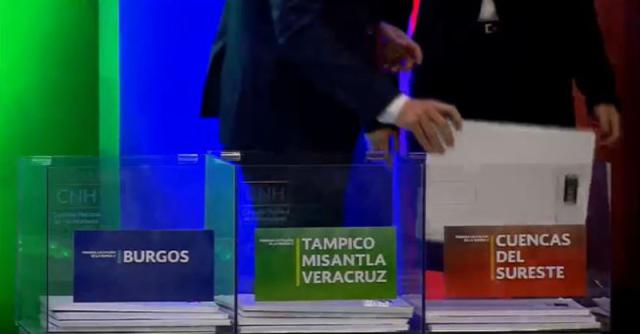
Some oil companies couldn’t resist the appeal of Mexico's Southeast Basin during the country's latest bidding round March 27, pledging tens of millions of dollars in cash payments and the maximum state share of operating profit, given large discoveries already made in the basin by Eni, a Talos Energy-led consortium and others.
The Gulf of Mexico (GoM) acreage was offered in three shallow-water basins—the others being Burgos and Tampico-Misantla-Veracruz—but competition for operating rights in the Southeast Basin was the fiercest. With an economic offer of about $59.8 million, the consortium of Eni and Lukoil outbid four others in its battle for Area 28. The consortium bid the maximum 65% state share of operating profit.
All eight of the blocks in the Southeast Basin received bids.
The “Southeast Basin is where big fields Cantarell, Ku-Maloob Zaap and Ayin-Batsil are located. The high bidding rates indicate the companies’ high interests in this basin on resource potential [90% oil] with existing infrastructure,” said Shuqiang Feng, upstream director for Stratas Advisors. “While, as results show, companies paid much less interest to the other two basin offerings—first time Burgos region and more gas basin Tampico-Misantla-Veracruz.”
Besides Eni and Lukoil, the winners—along with their proposed state share of operating profit and cash payment offer—included:
- Pemex (Area 29): 65%; about $13 million;
- Deutsche Erdoel, Premier Oil and Sapura E&P consortium (Area 30); 65%; about $51.1 million;
- Pan American Energy (Area 31), 65%;
- Total and Pemex (Area 32), 40.49%;
- Total and Pemex (Area 33), 50.49%;
- Total, BP and Pan American (Area 34), 50.49%; and
- Shell and Pemex (Area 35): 34.86%.
The Southeast Basin, or Sureste Basin as it is also known, was expected to generate the most interest. Even one area considered challenging—Area 35—because of its anticipated presence of extra heavy oil was awarded, said Alejandra León, director of IHS Markit’s Latin America upstream research team. She called the results “good considering that Burgos offshore is basically an unexplored area, and Tampico-Misantla is a complicated basin.”
In all, about 46% of the 35 blocks offered received bids. All of the bids were for shallow-water acreage in water depths less than 500 m. Mexican officials said the results show investors’ strong interest. This included interest in areas where there has been little exploration in the past: Tampico-Misantla-Veracruz and Burgos.
Speaking during a press conference after the round, Mexico’s Energy Secretary Pedro Joaquin Coldwell called the percentage of blocks awarded high. He pointed out some of the areas’ prospectivity for natural gas, saying “It’s one of our priorities to decrease our dependence on exports of natural gas.”
He also applauded state-run Pemex’s participation in the round. The company participated in six consortia and was awarded six contracts. That shows the company has become a “reliable and competitive international partner,” Coldwell said, achieving one of the objectives of the country’s energy reform.
Another positive was that half of the Southeast Basin blocks received the maximum government share of 65%, León noted.
Tampico-Misantla-Veracruz Basin: Pemex and partners dominated bidding Tuesday for blocks in the GoM’s Tampico-Misantla-Veracruz Basin, where there are prospective oil and gas resources, according to Mexico’s National Hydrocarbons Commission (CNH). Of the 13 blocks offered in this basin, four received bids.
The consortium that comprises Pemex, Germany’s Deutsche Erdoel and Spain’s Compañía Española de Petróleos was the lone bidder for areas 16 and 17, where it pledged state shares of operating profit of 24.23% and 35.51%, respectively.
Pemex partnered with Compañía Española again for Area 18, where the two faced no competition with their 45.51% economic offer.
The U.K.-headquartered Capricorn Energy Ltd. and Mexico-based Citla Energy consortium was the only bidder for Area 15. The consortium offered 27.88% and was declared the winner.
Mexico received no bids for the rest of the Tampico-Misantla-Veracruz areas.
Burgos Basin: About 29% of the 14 shallow-water GoM blocks in the Burgos Basin offered received bids. The areas, which together span 8,422 sq km of Mexico’s northeastern coast, are believed to be prospective for light oil and wet gas. Only Repsol, Pemex and Premier Oil dared to place bids in the underexplored area.
Repsol outbid Pemex to become the highest bidder for Area 5, proposing a 56.27% state share in operating profit compared to Pemex’s 23.89%. Spain’s Repsol was also the winning bidder—with no competition—for Area 12 with its 48.17% economic offer.
In addition, U.K.-based Premier Oil secured rights to operate in two areas—11 and 13—with economic offers of 29.43% and 34.73%, respectively.
No bids were received for the remaining blocks.
Juan Carlos Zepeda, head of CNH, noted that the number of contracts awarded during the latest round was up compared to the previous shallow-water Round 2.1 in which 10 contracts were offered. The contracts awarded March 27 involve nine additional exploration wells, he said.
Regarding production, “these 16 contracts are expected to result in a production of around 280,000 barrels per day with a peak in 2025 starting production in 2022. There is also a component of natural gas, but the main aspect of the Southeast Basin is oil,” Zepeda said. “Regarding natural gas, we expect 220 million cubic feet of natural gas with the same timeline.”
The opportunity to develop and produce oil from the Burgos, Tampico-Misantla-Veracruz and Cuencas del Sureste (Southeast) basins attracted three dozen companies as qualified bidders.
CNH said 36 companies (14 individual companies and 22 as bidders in a consortium) from 14 countries qualified to bid during the tender, its third round since Mexico decided in 2013 to open its energy sector to foreign investors.
California-headquartered Chevron was the only U.S.-based company among the qualifying bidders. The company placed no bids.
The shallow-water areas were tendered as production-sharing contracts, according to the CNH.
But “as we have been pointing out, the bid’s rules are not designed to bet on more investment commitments, so we saw a lot of zeros on the additional investment commitments, but [this was] not a surprise,” León added. “Just to keep things in context, the results of the bid rounds in Mexico have been really good, but it is still a long way to see the real success of the upstream opening in terms of the investment, oil and gas production, government income, job creations and multiplier effect in the Mexican economy.”
Velda Addison can be reached at vaddison@hartenergy.com.
Recommended Reading
E&P Highlights: Feb. 24, 2025
2025-02-24 - Here’s a roundup of the latest E&P headlines, from a sale of assets in the Gulf of Mexico to new production in the Bohai Sea.
McDermott Completes Project for Shell Offshore in Gulf of Mexico
2025-03-05 - McDermott installed about 40 miles of pipelines and connections to Shell’s Whale platform.
Valeura Boosts Production, Finds New Targets in Gulf of Thailand
2025-03-03 - Valeura Energy Inc. has boosted production after drilling three development wells and two appraisal wells in the Gulf of Thailand.
E&P Highlights: March 24, 2025
2025-03-24 - Here’s a roundup of the latest E&P headlines, from an oil find in western Hungary to new gas exploration licenses offshore Israel.
E&P Highlights: Jan. 21, 2025
2025-01-21 - Here’s a roundup of the latest E&P headlines, with Flowserve getting a contract from ADNOC and a couple of offshore oil and gas discoveries.
Comments
Add new comment
This conversation is moderated according to Hart Energy community rules. Please read the rules before joining the discussion. If you’re experiencing any technical problems, please contact our customer care team.






